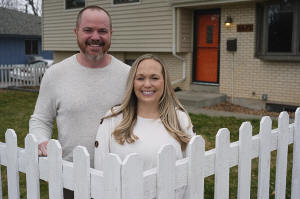More homes for sale and easing rates favor homebuyers this spring, but
affordability hurdles remain
[April 07, 2025] By
ALEX VEIGA
LOS ANGELES (AP) — This spring homebuying season is shaping up to be
more favorable for home shoppers than it's been in recent years — as
long as they can afford to buy.
Home prices are rising more slowly. Mortgage rates remain elevated, but
have been mostly easing and could be headed lower if the U.S. economic
outlook continues to darken over the Trump administration's widespread
tariffs, which have rattled financial markets and stoked fears of a
recession.
Most importantly, the number of homes on the market is up sharply from a
year ago.
While the inventory of homes for sale nationally is still low by
historical standards, active listings — a tally that encompasses all
homes on the market except those pending a finalized sale — surged 28.5%
last month from a year earlier, according to data from Realtor.com.
Listings jumped between 44% and 68% in many large metro areas, including
San Diego, Las Vegas, Atlanta and Washington D.C.
As homes take longer to sell, prices have started dropping in many
markets. The median listing price was down last month from a year
earlier in most of the nation's biggest 50 metro areas, including a more
than 6% drop in Austin, Miami and Kansas City.
These trends should give prospective homebuyers more leverage as they
negotiate with sellers this spring, though they are unlikely to be a
game-changer for many aspiring homeowners priced out of the market after
years of soaring prices.
“It’s a little hard to say that it’s a buyer’s market, but I’d call it a
much more balanced market than it’s been in the last couple of years,
where it’s really been a predominantly seller’s market,” said Joel
Berner, senior economist at Realtor.com.

Ryan Vasko and his wife, Whitney, recently navigated both sides of the
housing market equation in their move from Oregon to Colorado.
In December, the couple sold their three-bedroom, one-bath house in
Portland for $505,000. That was $10,000 below their list price, but
still above the $500,000 minimum they hoped to get.
At the same time, the couple searched for a home in the Denver metro
area, which is among the markets that’s had the biggest increase in
homes for sale this year. Active listings soared 67.3% in March from a
year earlier. As listings jumped, the median listing price fell 5.6% to
$585,000.
Last month, the Vaskos closed the deal on a four-bedroom, three-bathroom
house in Littleton, Colorado, about 10 miles south of Denver, that had
been on the market at least three weeks.
“We got under contract week one, we found out we were pregnant week two
and we put an offer on this house week three,” said Vasko, 41, a
creative director at an advertising agency.
The price: $680,000, or $5,000 above the list price. Still, the seller
agreed to cover the cost of lowering the couple’s 6.9% mortgage rate for
the first two years of the loan to 4.9% and 5.9%, respectively.
“It gives us a little wiggle room, if we need it,” said Vasko, noting
that he’s hoping to eventually refinance to a lower fixed rate.
A mixed market
The U.S. housing market has been in a sales slump since 2022, when
mortgage rates began to climb from pandemic-era lows. Sales of
previously occupied U.S. homes fell last year to their lowest level in
nearly 30 years. Easing mortgage rates and more homes on the market
nationally helped drive sales higher in February from the previous
month, though they were down year-over-year.
Last year, higher mortgage rates dampened the start of the spring
homebuying season. This year, the average rate on a 30-year mortgage is
down to 6.6% from just over 7% in mid-January, according to mortgage
buyer Freddie Mac, although that’s still elevated relative to the 2-year
low of about 6% it fell to in September.
Another plus for buyers: Lower prices. The median listing price fell in
March from a year earlier in 32 of the 50 largest metro areas, including
Kansas City, San Francisco, Miami and San Diego. Nationally, it was
$424,900 last month, unchanged from a year earlier, according to
Realtor.com.
The market shift may give home shoppers more leverage when sellers ask
that buyers waive home inspections. Sellers may also be more willing to
pay for closing costs, contribute cash to make repairs or make other
concessions, real estate agents say.
[to top of second column] |

Ryan Vasko and his wife are shown outside the home they just bought
after moving from Oregon, April 3, 2025, in Littleton, Colo. (AP
Photo/David Zalubowski)
 “Pretty much every buyer is asking
for concessions, unless they know that they are in a multiple offer
situation,” said Afton Hartmann, a Redfin agent in Denver.
Such situations, although less common than a few years ago, still
exist.
Gilad Hoffman, executive director at a synagogue, knew his home
search was over when he spotted a four-bedroom, 2.5-bath house for
sale in Escondido, 30 miles northeast of San Diego. He felt the
home, listed by the estate of its late owner for $1.079 million, was
“severely underpriced.”
Hoffman, 41, paid $13,000 above the asking price for the home in
February as he fended off bids from three other prospective buyers
-- including one offering to pay all cash.
Elevated mortgage rates didn’t dissuade Hoffman. He accepted a 7%
rate in exchange for a credit from his lender to put toward closing
costs.
“My philosophy going into the whole thing was: get into something
now that you can afford with these high interest rates,” Hoffman
said. “Hopefully in two years, they’ll come down and then you can
refinance. And that’s still my intention.”
Affordability and uncertainty are still hurdles
Despite some buyer-friendly trends, the housing market remains
largely out of reach for many Americans, especially first-time
buyers who don't have home equity gains to put toward a new home.
While home price growth has been slowing, the decline is negligible
against the 47% gain in prices over the last five years.
And while home listings are up, many more are needed to return the
market to more of a balance between buyers and sellers. Consider,
there were 1.24 million unsold homes on the market at the end of
February. While up 17% from a year earlier, that's still about 44%
below the 2.21 million monthly average going back to 1999, according
to data from the National Association of Realtors.
As of January, a household earning the median U.S. annual income of
$79,223 would have to spend 47% of that to cover payments on a home
at the median price of $390,333. That share of income matches the
highest it has ever been on records going back to 2005, according to
the Federal Reserve Bank of Atlanta. When the annual cost of
homeownership exceeds 30% of the median U.S. household income, it’s
considered unaffordable by the Department of Housing and Urban
Development.
If the decline in mortgage rates accelerates in coming months, that
would boost homebuyers' purchasing power.
Economic forecasts generally have the average rate on a 30-year
mortgage staying around 6.5% this year, but those forecasts may be
outdated now.
A sharp downward move last week in the 10-year Treasury yield as
bond investors reacted to rapidly escalating trade war between the
U.S. and nations around the globe points to lower mortgage rates.
The yield on the 10-year Treasury note, which banks use as a guide
to pricing home loans, dropped to 4.01% Friday, its lowest level
since October, as global trade tensions escalated.

Still, tariffs are typically inflationary, and the 10-year Treasury
yield tends to rise on expectations of higher inflation. That could
keep mortgage rates where they are, or nudge them higher.
If the trade war worries do pave the way for further mortgage rate
drops, “those lower rates may be cold comfort to prospective buyers
who are increasingly worried about job security and inflation,” said
Lisa Sturtevant, chief economist at Bright MLS.
All contents © copyright 2025 Associated Press. All rights reserved |